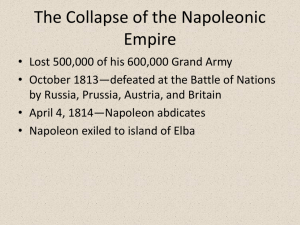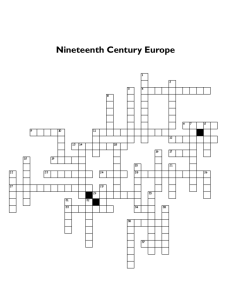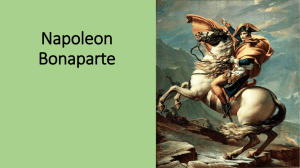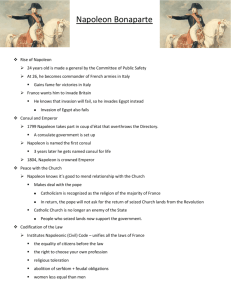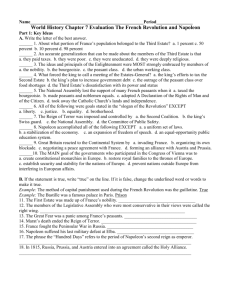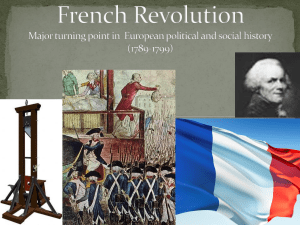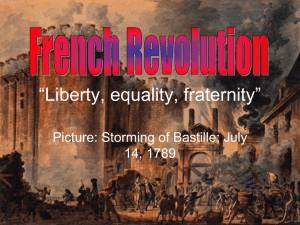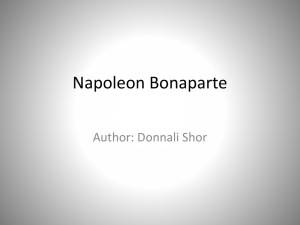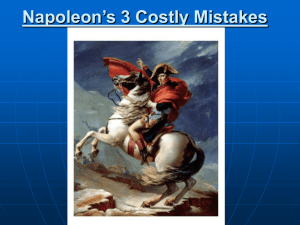AGE OF NAPOLEON - University High World History
advertisement
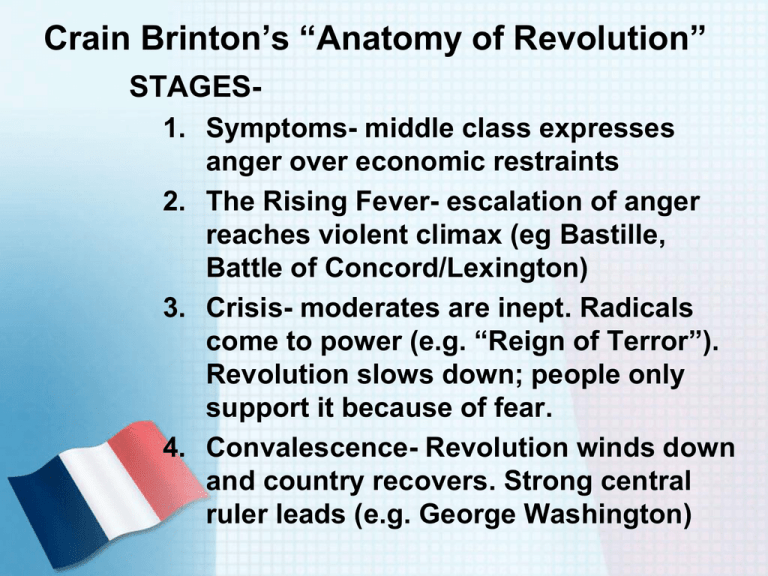
Crain Brinton’s “Anatomy of Revolution” STAGES1. Symptoms- middle class expresses anger over economic restraints 2. The Rising Fever- escalation of anger reaches violent climax (eg Bastille, Battle of Concord/Lexington) 3. Crisis- moderates are inept. Radicals come to power (e.g. “Reign of Terror”). Revolution slows down; people only support it because of fear. 4. Convalescence- Revolution winds down and country recovers. Strong central ruler leads (e.g. George Washington) HAITIAN REVOLUTION (1789-1804) I. Social Turmoil 1. White plantation owners politically discriminated against gens de couleur (mixedrace planters) 2. Sugar plantations notorious for hash working conditions • Mortality rate very high. Most slaves were African born as a result 3. Events of 1789 in France caused political instability in Saint Domingue. Whites and gens de couleur fight. 4. Toussaint L’Ouverture, former slave, leads slave only successful slave rebellion in history AGE OF NAPOLEON 1796-1815 I. Rise to Power 1. Excelled as artillery officer. Drove British forces from French port of Toulon 2. Victories against Austrians. Took all of Italy, much of central Europe 3. Failed to occupy Egypt 4. Returned and led coup d’etat in 1799. Set up 3-man Consulate; became First Consul; Consul for life in 1802. 5. Invited Pope to crown him Emperor of France II. Napoleon’s reforms 1. Set up system of public schools- lycee 2. Napoleonic Code • • • • Legal rights Religious toleration Meritocracy Women lost power they had gained in Revolution 3. Made peace with Catholic Church through Concordat of 1801 III. Building an Empire 1. Conquers Netherlands, Belgium, Italy, parts of Prussia 2. Abolishes Holy Roman Empire and creates Confederation of the Rhine 3. Conquers Spain and places his brother on throne 4. Forced alliances on Prussia, Austria, and Russia 5. Britain: strong navy. Napoleon imposed Continental System IV. Retreat and Defeat 1. Rise of “Nationalism” works against Napoleon • Resent foreign rule and Continental System 2. Resistance in Spain, brutal repression 3. Russia withdraws from Continental System and Napoleon marches for Moscow on June 22, 1812 • 690,000 men largest army ever assembled 4. Russians used “scorched earth policy” as they retreat deep into Russia. 5. Moscow is deserted, residents set fire to their own capital!!! V. Exile and a Curtain Call 1. Combined armies of Russia, Britain, Austria, and Prussia defeat Napoleon at Battle of Nations 1813. 2. Exiled to island of Elba…but he escapes in 1815!!!! 3. Battle of Waterloo is final defeat. June 18,1815 4. Died on island of St. Helena in 1821 VI. Legacy: Congress of Vienna 1815 1. Goal- create lasting peace. Established balance of power and protected monarchies 2. Created Prussian buffer around France and restored Bourbon line (Louis XVIII) Revolutions Sweep Europe! 1. “National self-determination” sentiments spread across the globe – – Greece gains independence from Ottomans in 1820 Britain, France, and U.S. extend voting rights (franchise) 2. Nationalist democratic revolutions in Europe 1848

